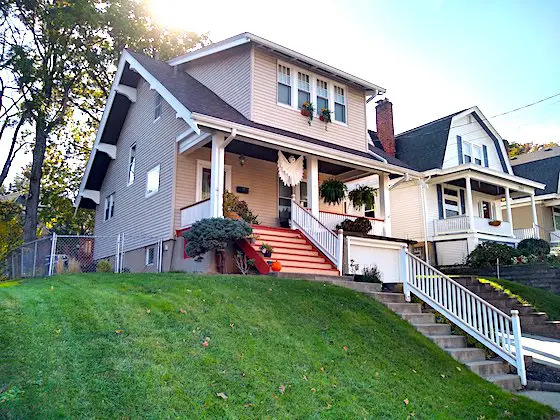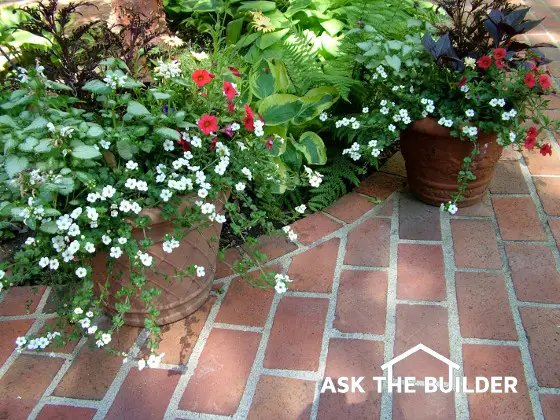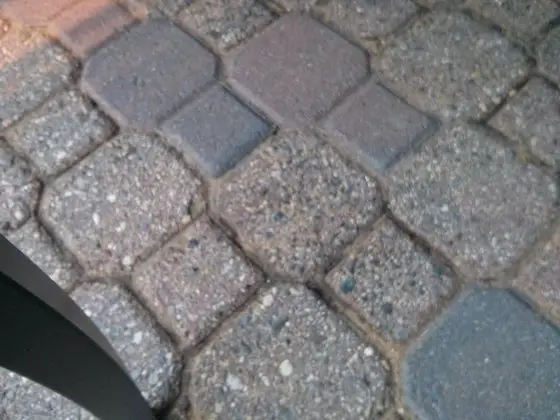Patios of Brick – Concrete or Clay

Brick Patios | This is the first house I owned! It's at 2865 Minto Avenue in Cincinnati, OH. The house is in marvelous shape. I took this photo in October of 2019 when I was back there visiting dear friends. See those windows on the second-floor dormer? My helpers and I created a chute that extended down and out from the window on the right. I remember dumping all the plaster from the second-floor rooms into it and from there it slid down into Tony Albanese's 1-ton dump truck in the driveway. I installed those concrete steps up from the sidewalk and they're still in amazing condition 44 years later!
Brick Patios and Walkways - The First Attempt Failed
Kathy, my lovely wife, and I bought our first home in April of 1975. It needed a tremendous amount of work. When I first walked upstairs and into the master bedroom, there was an 18-inch skylight you could see out to the sky. Yes, a gaping hole in the roof!
It was an FHA repo located at 2865 Minto Avenue in Cincinnati, Ohio. The previous owners had defaulted on the mortgage. We bought it at an auction for $8,500. I spent the summer of 1975 with three helpers transforming it into a wonderful first home.
We fixed it up and sold it for $35,000 within ten months. I reinvested the profits from the house into a much larger house in Pleasant Ridge located at 6270 Robison Road.
Amateur Scientist
By that time, I was consumed with learning about building, rehabilitation, and remodeling. I was doing various experiments with techniques and materials. Yes, experiments. That's what most rookies and homeowners do with building and remodeling projects, they experiment. It's important to realize I was just 22 years old when I purchased that house on Minto Avenue. I was filled with enthusiasm, but was empty on experience!
You see, most people try to do a job and hope for good results just like a chemistry experiment. Anyway, I decided to experiment and put in a brick paver sidewalk at the second home on Robison Road.
Paver brick is not flagstone, but the installation of both materials is nearly identical. Continue reading this article and you'll discover how to install flagstone. You can also read about flagstone installation here.
What Brick Did you Use?
One day while picking up supplies at a brickyard I saw these neat, thin red clay paving bricks. They measured 4 inches wide by 8 inches long by 1.5 inches thick.

This patio was built with traditional clay brick pavers that are 4 x 8 x 1.5 inches thick. This is the exact same brick and look I did with my brick paver sidewalk at my second home on Robison Road. PHOTO CREDIT: Tim Carter
I asked what they were used for. The yard manager said that people used them for patios and walkways. Ah ha! Just what I needed.
Now, mind you, this was before those fancy-dancy interlocking concrete brick paving materials. I came home and told Kathy I had found a great product. In fact, I showed her a sample brick. She loved it. I had decided that setting the brick on a smooth bed of sand would make for a great surface.
How Did You Install the Paver Brick?
I dug the lawn up and carefully installed the sand. I put in about 4 inches of medium sand. I then used a straight edge to make the top surface as smooth as glass.
Each brick was placed up against an adjacent brick. It was a good-looking job - that is, for a while. Before long, weeds began to grow between the joints. The neighborhood ants colonized my walkway as well. The first explorers found out how easy it was to mine the sand for ant farms. One year later I started over.
How Did You Install the Brick the Second Time?
My brick paver experiment started in the summer of 1977 with the sand disaster. I then corrected it the summer of 1978. I took out the brick, salvaged them and dug up the sand setting some aside to use in my second installation. The rest I wheelbarrowed to the backyard.
I then poured a 5-inch thick concrete walkway with 1/2-inch steel rebar in the center of the concrete. The top of the concrete was 2 inches below where I wanted the top of the brick sidewalk.
I then mixed up Portland cement and the sand to use as a mortar to lock the paving brick to the concrete. I left a 1/2-inch space around each brick to add more mortar using a mortar bag much like a baker uses an icing bag to decorate a cake. It was a labor of love.
Do the Paving Brick Come in Different Thicknesses?
Yes, you can get different thickness paving brick. Be sure to read this column about exterior brick durability before you make your final decision. If you're thinking of a brick patio, you must first decide on your material before you begin work. There are two primary materials: standard clay brick or fine-grained concrete brick. The clay paving bricks are available most often in rectangular sizes approximately 4x8 inches. They can be purchased in two standard thicknesses: 1 1/2 inch and 2 3/8 inch.
Do Paving Brick Fade?
I'm partial to clay paving bricks because the color never fades. The color of the brick is solid throughout the entire brick. This is not the case with concrete paving bricks.
The concrete paving bricks are available in a range of shapes and sizes. Often they are available in five or more colors. These bricks are usually only available in one thickness - 2 3/8 inch. They're an excellent example of the new mortarless technology that has blossomed in the past 15 to 20 years.
My only issue with these concrete bricks is color fade. Pressure washing concrete paving bricks will destroy them in short order. The high-pressure stream of water erodes the thin coat of pigmented cement paste from the sand and gravel aggregate. Look at this photo of what happens when you pressure wash concrete paving bricks:

Here's a great example of faded concrete paving brick next to brand new ones that have not yet lost the colored cement paste off the sand and gravel. Copyright 2017 Tim Carter
Robert emailed about plans for a new brick patio. CLICK HERE to read his emails and my answer.
Column B409